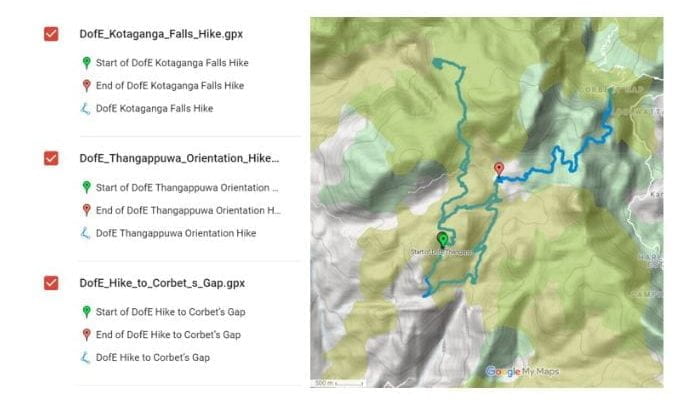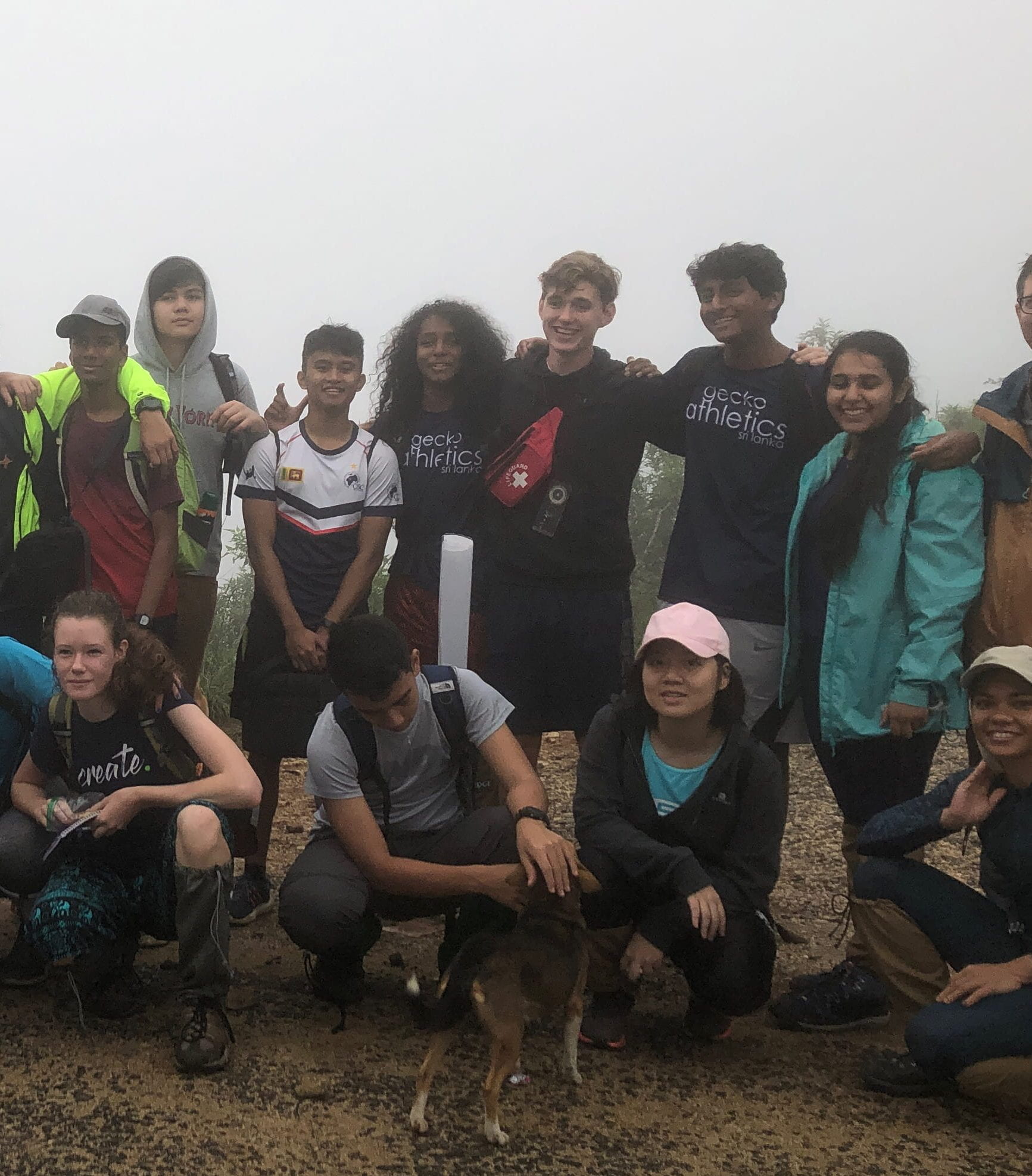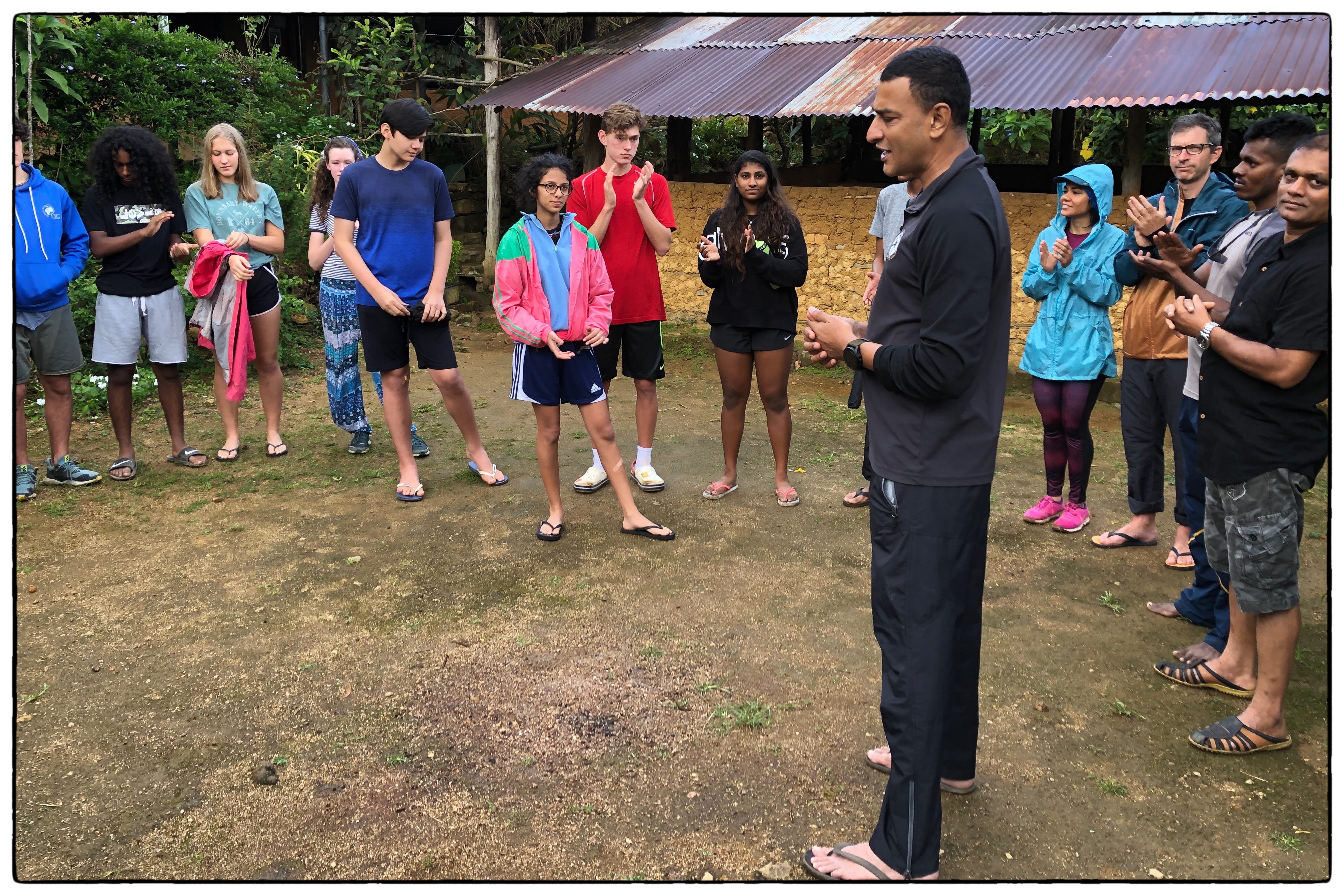Preparation
Our main preparation for the Duke of Edinburgh Practice Adventurous Journey into the Knuckles region of Sri Lanka came in the form of the orienteering session (which can be read about in-depth in a previous post) earlier in the year. Aside from this, we did mandatory first-aid training during our Bronze award progression as well as two expeditions into the Sinharaja Rainforest in the previous year (which acted as the practice adventurous journey and adventurous journey respectively for my bronze award progression). Ultimately, we were well prepared for our journey and the group was characterized by a mood of excitement before we set off.
Journey

Routes of the three hikes (Credits: Ian Lockwood)
<iframe src=”https://www.google.com/maps/d/embed?mid=1qWolS8zjezAHLpnzoM-HBU8Q-fYM2HZ-” width=”640″ height=”480″></iframe>
Day 1
The 2019 Duke of Edinburgh Practice Adventurous Journey commenced with a 5-hour bus ride to Sri Lanka’s knuckles region. Upon our arrival, we ate a quick lunch, received a briefing, and were off on our first hike. The purpose of this preliminary jaunt was simply to familiarize ourselves with the landscape as well as our roles within our teams (mine was comprised of myself, Rika, Ariyanna, Muneera, Christopher, and Mathisha). We ended up hiking for approximately 8.5 kilometers stretched out over about 3 hours, through a beautiful, lush forest slightly to the south of our main campsite. This particular venture turned out to be a perfect opportunity for me to explore my DOE focus project: the juxtaposition of manmade objects in natural landscapes and their impact on the environment. As someone who has lived in an urban environment for most of his life, experiencing nature to its full extent is a great opportunity for me. However, now more than ever, humanity is invading natural habitats and developing land far beyond the reach of major cities. I wanted my focus project to explore this global issue and I eventually settled on photography as a medium for sharing my findings throughout the journey. Two (of the more than a dozen) photos are attached below.


Top: Construction of a school in the knuckles. Bottom: Building in a field.
Day 2

By far the longest and most physically demanding hike of the session came on the second day. The proposed route took us from our campsite all the way to Corbet’s Gap further in the knuckles, and would ultimately span approximately 14 kilometers which we would trek for over four and a half hours. Shortly after we began the journey back to camp, the skies opened up and we were drenched by a torrent of rain for the entire rest of the trek. These final 2 hours of the hike were truly a struggle, and the feeling of returning to camp and the dry warmth of our tents could only be described as incredible. After we dried off, we convened at the common area and created a plan for the rest of the day. The first order of business was lunch, which consisted of a varied selection of curries, followed by a short siesta which we spent napping in our tents. Upon waking, we all began to work on our route cards as teams. We did this for approximately 2 hours and then ate some extremely delicious grilled chicken. Finally, we enjoyed some free time which we spent playing cards (I played hearts with a few of my friends and shot the moon twice in a row) and settled in for a good night’s rest.
Day 3

Our final day in the knuckles began with a morning hike to a beautiful waterfall. The journey took us through tea fields, mountains, and valleys, and provided me with some of the best views that I have ever seen. Once we reached the falls, we quickly changed into our swimsuits and jumped in for a quick swim. The mountain water was some of the coldest that I have ever felt, which elicited a reaction of shouts and splashing from all of us. After about 30 minutes in the water, we exited, changed again, and departed on our journey back to the campsite. The total hike was around 13 kilometers and took just shy of 5 hours. Once we arrived back in camp, we packed our bags up, had a small (but delicious) lunch of premade curries and got on the bus. This final 5-hour leg marked the conclusion of the 2019 Duke of Edinburgh Practice Adventurous Journey.
Focus Project
An Essay on Rural Development in Sri Lanka
My interest in rural overdevelopment began on a trip to the Kithulgala area of central Sri Lanka. During my stay, I had a chance to observe the construction of the Kithulgala Dam and discuss its implications with members of the local community, and it was through this process that I gained a much more thorough understanding of both the positive and negative effects of rural development on local populaces. In particular, my discussion with a local woodworker helped me realize the negative impacts for the economy that the dam had, such as the disruption of Kithulgala’s tourist industry as a result of the loss of several of its famed river rapids due to insufficient water flow. Being able to fully consider the unintended consequences of a seemingly beneficial infrastructure project opened my eyes to the realities of development and the way that it can shift local economies in a negative direction.
After being initially fascinated by rural development in Kithulagala, I wanted to carry my curiosity forward and explore the issue further during the Duke of Edinburgh Practice Adventurous Journey into Sri Lanka’s mountainous knuckles region. More than anything, I hoped to understand whether or not what I had seen in Kithulgala was applicable to other areas of the island. Upon our arrival, I immediately noticed large black barrels scattered around the landscape. Although I was initially a bit confused, I thought nothing of it until our first hike, at which time I realized that the barrels which had been discarded were once full of asphalt epoxy resin and were being used for the construction of a new road. As we approached the site of construction, a sharp, oily smell penetrated our nostrils and smoke filled the air. The great urbanization machine had reached the knuckles.
Moving on through our journey there were countless more examples of development; from backhoes in the middle of the jungle to the construction of a new schoolhouse. However, there was a clear tension between the seemingly surging development and another, more hidden side of the knuckles. While we saw new roads, schoolhouses, and infrastructure, we also came across several abandoned houses, vehicles, and shrines. As more and more time passed, the rural development that I saw seemed oddly ironic. The area’s abandoned houses made it appear devoid of humanity, and yet there was almost constant construction. This seemingly gratuitous development had not only negative effects on the environment but, as I had learned in Kithulgala, potentially on the people as well.
Based on my experiences in both Kithulgala and the knuckles I can definitively say that Sri Lanka is experiencing a period of rapid growth and modernization which may have unintended negative consequences. The country’s pristine wilderness is at a great risk of harm, and I would thus urge the Sri Lankan government and people to realize that urbanization is not as important as the protection of the island’s natural, untouched beauty, and moreover, that preservation of nature could have positive long-term economic impacts (such as the growth of the thriving Kithulgala tourist industry centered around whitewater rafting). Ultimately, though the benefits of rural development are certainly tantalizing, it is important to focus on Sri Lanka’s most defining characteristic (its natural beauty) and to turn our efforts to its preservation.
Reflection
General reflection on the journey
The journey provided me with a valuable opportunity to prepare and practice for my final adventurous journey in several ways. Firstly, it allowed me to explore all of the different roles that are present within the teams and to familiarize myself with each of their specific duties. Moreover, I was able to begin to work on my focus project during this venture, which certainly acted as useful preparation for the final journey. Ultimately, I believe that the practice adventurous journey was an absolute success due to the opportunities for practice and improvement of skills with which it provided me.
Learning Outcomes
My experiences leading up to and throughout the practice adventurous journey can be relevantly tied to several learning outcomes, mostly relating to developing skills, engaging with global issues, and considering actions.
- Demonstrate that challenges have been undertaken, developing new skills in the process
- Camping for several days is a challenge for almost anyone, and I certainly was able to develop new skills in the process (including route-card writing, leadership, and skills associated with various roles present within the teams).
- Demonstrate the skills and recognize the benefits of working collaboratively
- One of the most important facets of the Duke of Edinburgh program is teamwork, and I had an amazing chance to improve my collaborative skills in the setting of the practice adventurous journey. Working in a small team and, in fact, in a much larger group throughout the journey has allowed me to demonstrate the skills and recognize the benefits of working collaboratively.
- Demonstrate engagement with issues of global significance
- My engagement with issues of global significance throughout the practice adventurous journey came primarily in the form of work on my potential focus project. Overdevelopment of the natural environment and human habitat invasion are massive problems which lend to the overarching issue of climate change as a result of human forces, and this issue is one that I hoped to explore and engage with throughout the duration of the practice adventurous journey as well as into the final journey.
- Recognize and consider the ethics of choices and actions
- My experience with this learning outcome can be directly tied to my relationship with the previous one. By engaging with the globally significant issue of human development in natural spaces, I was able to recognize, evaluate and consider the ethics of actions and choices that are made in the world today regarding urban expansion. These two learning outcomes were extremely interesting and valuable for me to explore, especially as someone who has worked on solutions to climate-related issues in the past (take, for example, my personal project work; in which I built a model home designed for climate refugees or disaster-prone areas).
